Exploring Waterfront Development in Dubai's Marina
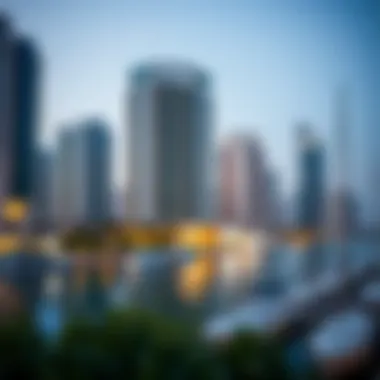
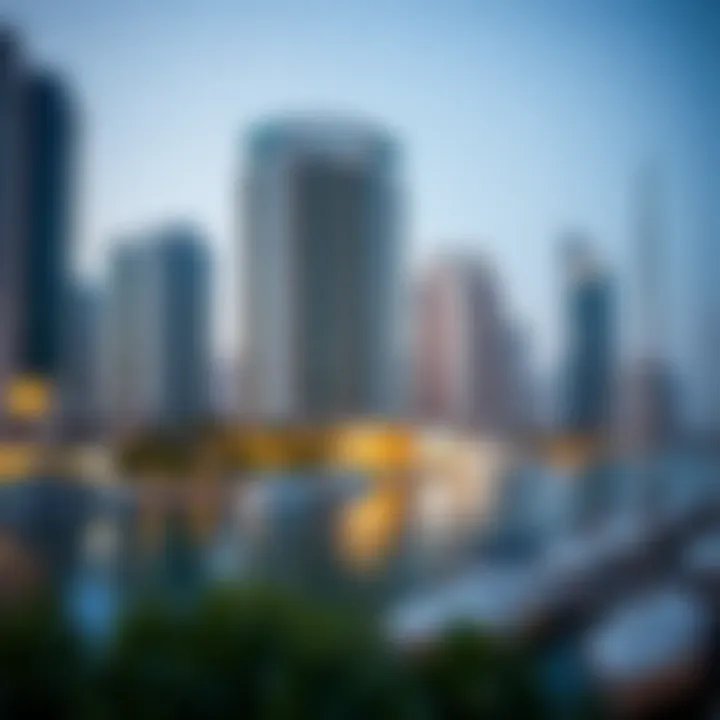
Intro
Dubai’s coastal transformation is nothing short of captivating. With its glittering skyscrapers reflecting off serene waters, the waterfront development scene has become a hallmark of the city. However, there’s more to these developments than just picturesque views. This article dives into the architectural nuances, surrounding community influences, environmental considerations, and the pivotal role of investors in shaping this aquatic landscape.
Understanding the intricacies of marina facades, both on a structural and social level, is vital for anyone immersed in Dubai's real estate. Developers, investors, agents, and expatriates alike need to grasp the ongoing trends and future potential within this flourishing market. As the emirate positions itself as a key player on the global property stage, the assessment of waterfront aspects sheds light on its potential.
As we delve deeper into the many facets of waterfront development, the interplay between market trends, investment opportunities, and community dynamics will unfold. Let's explore how these elements intertwine to shape a vibrant and inviting urban environment.
The Concept of Marine Interfaces
Waterfront development in Dubai has transformed the city into a remarkable panorama of skyscrapers and vast blue waters. The concept of marine interfaces plays a significant role in shaping this vibrant landscape. It's not just about the buildings rising against the skyline, but how these structures interact with water bodies, creating vivid connections between land and sea. Understanding marine interfaces is essential for stakeholders including investors, urban planners, and those living in or near these developments. It offers insights into not only the aesthetics but also the functionality and sustainability inherent in such projects.
Definition and Importance
Marine interfaces can be defined as the transitional spaces where the terrestrial environment meets aquatic systems, encompassing coastlines, riverbanks, and waterfront areas. These areas are crucial because they serve multiple purposes including recreation, habitat for wildlife, and a buffer against climate impacts.
The importance of these interfaces cannot be overstated:
- Cultural Significance: They often host waterfront promenades, parks, and public areas that enhance the community’s social life.
- Economic Value: A thriving marine interface attracts tourism and stimulates business, contributing heavily to the local economy.
- Environmental Balance: Effective marine interfaces can help maintain ecosystems through careful planning and sustainable practices.
Moreover, the design and development of marine interfaces can drastically influence the property values in the vicinity, making them a hotspot for real estate investment.
Historical Context
Delving into the historical aspects, Dubai’s marine interfaces have evolved significantly over the decades. In the early days, the coastline was predominantly natural with limited access. The advent of oil revenues in the late 20th century prompted a dramatic shift.
Local governance initiated ambitious seaside projects aimed at showcasing the emirate’s wealth and modernity. Noteworthy milestones include:
- Dubai Marina: This is a prime example of a well-planned waterfront that began construction in the early 2000s. It's now home to luxury apartments and buzzing leisure districts.
- Palm Jumeirah: A bold development featuring an artificial archipelago that redefined coastal development, showcasing human ingenuity and ambition.
As development took shape, challenges began surfacing—climate change and environmental degradation being major concerns. Thus, the tradition of enhancing marine interfaces with economic, ecological, and cultural benefits has grown increasingly relevant, blending innovation with historical legacy.
“Urban waterfronts should reflect sustainable practices that encompass both nature and community.”
Examining the past informs future developments and underscores the necessity of respecting natural dynamics while pursuing growth in Dubai's waterfront landscape.
Architectural Innovations in Waterfront Developments
Architectural innovations in waterfront developments serve as the backbone of any successful project, especially in a unique locale like Dubai. The integration of aesthetics and functionality is paramount in creating spaces that not only appeal visually but also enhance the livability and sustainability of the area. When one considers that Dubai is positioned along the coast, the design elements employed in these projects can significantly influence the ecological landscape, urban experience, and property market appeal.
Architectural ingenuity goes beyond mere beauty; it also encompasses the latest technologies to ensure that buildings withstand the testing climate and environmental conditions typical of the Gulf region. Key factors to consider include the thoughtful layout of buildings to maximize views of the water while minimizing sun exposure. Moreover, utilizing materials that reflect the local context and withstand humidity creates an environment that is both inviting and practical for residents and visitors alike.
"Successful waterfront architecture can be a catalyst for urban regeneration, attracting residents and investors alike."
This is particularly relevant when you introduce features like public promenades, parks, and engaging waterfront experiences that foster community interaction. Spaces that encourage social activities and provide breathtaking views not only enhance the overall enjoyment but also raise property values in the vicinity, offering a win-win for investors and the local government.
Design Principles
When contemplating the design principles of waterfront developments, several critical aspects come into play. Firstly, contextual design is vital. Architectural designs should consider the immediate environment, including climate, local culture, and the marine ecosystem. For instance, in Dubai, designers often take inspiration from both traditional Islamic architecture and contemporary styles, creating a harmonious blend that respects historical context while pushing boundaries.
Another crucial consideration is sustainability. Many waterfront projects in Dubai now employ green building practices. This includes natural cooling systems, solar panels, and materials that are eco-friendly. Not only do these practices benefit the environment, but they can also lead to operational cost savings over time. Besides, ensuring that developments include adequate drainage and flood resistant features is non-negotiable in a coastal city.
Also, it’s worth noting the integration of smart technologies. Features such as smart meters, environmental monitoring systems, and efficient waste management systems are becoming standard. These technologies not only improve the living conditions but also position the market to be more adaptive to future challenges.
Case Studies of Iconic Structures
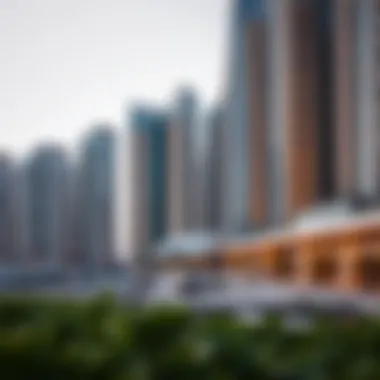
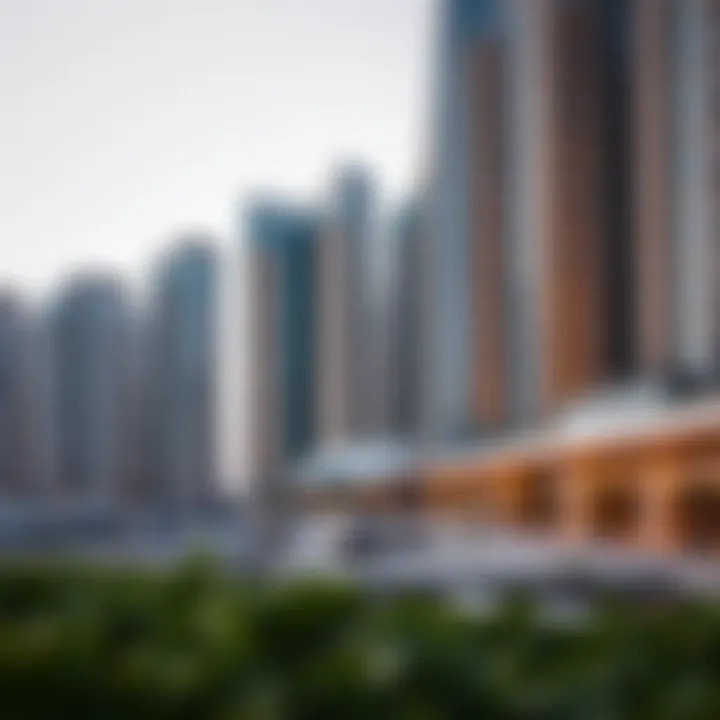
Examining specific case studies sheds light on how architectural innovation shapes waterfront development in Dubai. One prime example is the Dubai Marina, which showcases how thoughtful design can result in a vibrant community. With stunning high-rises overlooking the water, the marina embodies the vision of luxurious living interwoven with recreational opportunities.
Secondly, consider Bluewaters Island, home to the famous Ain Dubai, the world’s largest observation wheel. This development doesn't just offer spectacular visuals; it integrates walkable spaces that connect residents and visitors alike, thereby enhancing the overall urban experience.
Furthermore, the Palm Jumeirah stands as an awe-inspiring feat of engineering and design. This artificial island has redefined the coastline, illustrating how strategic planning and innovative construction techniques can transform geographical contours into luxurious living spaces.
In summary, these case studies highlight that successful waterfront developments blend innovative design principles with an understanding of ecological impact and community integration. They serve as blueprints for future projects and underline the importance of keeping at the forefront of architectural trends and sustainability practices.
Environmental Considerations
In recent years, the significance of Environmental Considerations within waterfront development projects in Dubai has surged to the forefront of urban planning discussions. This stems not just from regulatory pressures but a growing awareness among investors and residents alike about sustainable living and responsible resource management. As Dubai continues to expand its waterfront allure, understanding the ramifications of construction on the environment is pivotal for anyone looking to engage with this dynamic market.
Sustainability Practices
Sustainability practices are at the heart of modern urban design, especially in a place like Dubai, which thrives on innovation. Developers now emphasize eco-friendly building materials and renewable energy sources. Many new projects incorporate green roofs, which not only reduce heat but also promote biodiversity by supporting various plant and animal species.
Incorporating smart grids helps to optimize energy consumption, signaling a shift towards more efficient urban living. Also, water conservation techniques, such as recycling and purification systems, can drastically reduce waste. These methods not only lessen the environmental footprint but also appeal to environmentally conscious investors and residents.
Key Sustainability Practices Include:
- Use of solar panels and wind turbines to power buildings.
- Rainwater harvesting systems to conserve water.
- Implementation of living walls and green spaces to promote local flora.
- Efficient waste management practices to minimize landfill use.
As these practices gain traction, they play a crucial role in ensuring that Dubai's waterfront projects remain not only visually stunning but also environmentally friendly.
Impact on Marine Ecosystems
Waterfront development inherently poses risks to marine ecosystems, a critical consideration in an investment-savvy marketplace like Dubai. The marine life surrounding the coast must be considered, particularly in areas like Dubai Marina where building activities can disturb delicate habitats.
The impact can be seen in various ways:
- Sedimentation: Construction often increases sediment levels, which can impede sunlight penetration, hampering photosynthesis for underwater plants.
- Pollution: Runoff from construction sites can introduce harmful contaminants into the water, affecting fish and other marine life.
- Designed green corridors: To mitigate these negative effects, innovative approaches such as constructed wetlands and artificial reefs help to restore and improve local biodiversity while enhancing the overall aesthetic of the waterfront.
- Community engagement efforts also aim to raise awareness and promote better practices that safeguard marine environments.
The delicate balance between urbanization and nature preservation in Dubai exemplifies the challenges faced in contemporary real estate development. Builders and planners need to factor in these environmental considerations to align with public expectations and global sustainability standards.
"Understanding the impact of waterfront development on marine ecosystems is not just about preserving nature but about promoting long-term viability for our communities."
Investors with a finger on the pulse of these environmental considerations are likely to make more informed decisions that support both ecological integrity and economic growth in Dubai's thrilling property landscape.
Market Dynamics in Dubai's Waterfront Properties
Understanding market dynamics in Dubai's waterfront properties is essential for anyone looking to invest or reside in this vibrant and ever-evolving marketplace. The properties lining the dazzling coastline not only offer stunning views but are also enveloped in a rich tapestry of economic trends, community needs, and environmental shifts. The unique position of Dubai as a global hub makes these dynamics particularly important for prospective buyers, investors, and real estate agents alike.
The interplay between demand and supply forms the crux of market dynamics in this bustling sector. With growing interest from expatriates and international investors seeking luxury living and investment opportunities, the market has witnessed an impressive surge. There’s a heightened competition which pushes developers to innovate and create more desirable properties, integrating state-of-the-art amenities and sustainable features.
Moreover, the continued investment in infrastructure and transportation enhances the overall appeal of waterfront properties. New hotels, restaurants, and facilities sprouting up like mushrooms after rain underscore the commitment to developing these areas into vibrant communities rather than just residential havens.
One cannot overlook the intense scrutiny on regulatory frameworks and government support geared at encouraging investment. Policies set forth by the Dubai government have provided the impetus needed for investors to feel confident in their decisions, bolstering liquidity and facilitating growth.
Investment Trends
Investment trends within Dubai's waterfront properties have morphed rapidly, especially in recent years. Investors are gravitating towards mixed-use developments that blend residential, commercial, and leisure elements. High demand for these types of projects indicates a shift in lifestyle preferences, with more people desiring spaces that offer convenience.
- Buyers are leaning towards sustainability: Environmentally friendly developments are no longer a trend but a necessity. Properties that emphasize green building practices or offer renewable energy solutions tend to attract more interest.
- Luxury and exclusivity drive market movement: Buyers are keen to invest in properties that promise high-end amenities, like private beaches or exclusive yacht access. The allure of luxury is a potent driver of investment and a reliable barometer of market stability.
- Foreign investment flows: Post-pandemic, the trend toward international buyers has become more pronounced, with property ownership laws being more accommodating, particularly for expatriates. This represents a significant shift, offering opportunities for high yields and diverse portfolios.
Price Movements and Valuation
Price movements in Dubai's waterfront property market tell a compelling story of resilience and opportunity. The initial dip in prices during the pandemic has given way to a robust recovery, suggesting that the market’s value may be more stable than previously thought. This fluctuation reflects broader economic trends, but also unique local factors:
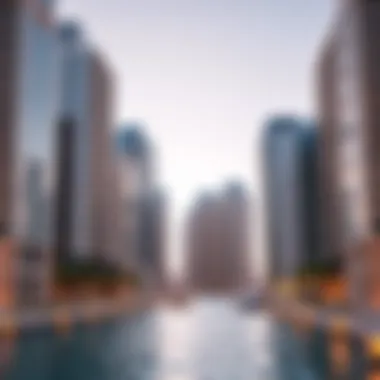
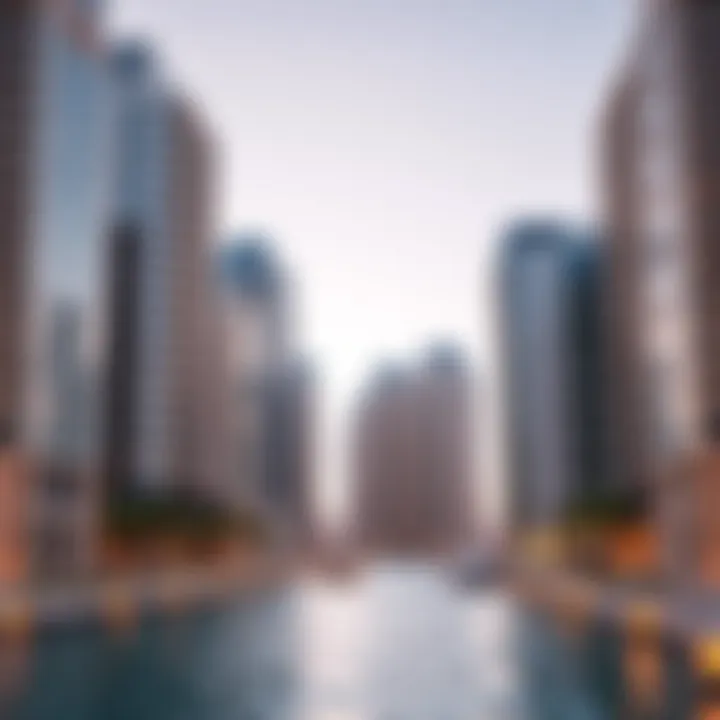
- Demand vs. supply: A lag in new development projects means that as demand rises, prices can be expected to move upwards. Active interest from investors creates a ripple effect, causing valuations to escalate in sought-after neighborhoods.
- Valuation techniques are adapting: Real estate analysts are increasingly employing a mix of traditional appraisal methods and real-time data analytics to forecast and assess property values. Technology integration is transforming how properties are valued, providing a clearer picture for investors.
"Recognizing the trends in market dynamics is crucial for anyone looking to make a savvy investment in Dubai's waterfront properties. The landscape may change, but informed choices rooted in solid analysis will always stand the test of time."
Community and Lifestyle Integration
The concept of community and lifestyle integration plays a pivotal role in enhancing the vibrancy of waterfront developments in Dubai. It is essential that these developments do not merely serve as isolated enclaves but rather foster a sense of belonging and interconnectedness among residents and visitors alike. Integrating various community aspects into these marine interfaces ensures that people can engage with their surroundings, enhancing the waterfront experience immensely. The benefits of this integration are multi-faceted, influencing urban development, social cohesion, and overall quality of life in the bustling metropolis.
Public Amenities and Spaces
Public amenities and spaces are the backbone of any thriving community, especially in waterfront developments. When people think of a marina, they often picture luxurious yachts and shimmering waters, but what truly enriches these areas are the spaces that invite people to gather, interact, and enjoy their environment.
In Dubai, one can find a plethora of well-planned public spaces such as parks, pedestrian walkways, and recreational zones that line the marinas. For instance, the Dubai Marina Walk provides a picturesque promenade filled with restaurants, cafes, and shops that offer a variety of dining and shopping experiences. This pedestrian-friendly setup encourages foot traffic, making it easier for families, joggers, and tourists to seamlessly connect with the waterfront.
Additionally, thoughtful landscaping and local art installations inject a sense of identity and community spirit into these spaces. It’s not uncommon to see families picnicking, friends enjoying evening strolls, or artists displaying their work, all contributing to a vibrant community atmosphere. Moreover, public amenities like children's play areas and fitness zones promote a healthy lifestyle, bringing together different age groups and fostering social interactions.
People become the heart of these spaces, making it an enriching experience not just for residents but for visitors too. By prioritizing accessibility and inclusivity, waterfront developments can ensure that everyone, regardless of their background or lifestyle, feels welcomed and valued.
Social Interactions and Networking
On the social side, the integration of lifestyle elements within the community creates a vibrant network for interpersonal relationships. The waterfront settings often serve as a melting pot for different cultures, housing a diverse range of people from all over the globe. This diversity can lead to rich networking opportunities, fostering connections that might not occur in more traditional urban settings.
The availability of venues such as co-working spaces, lounges, and art galleries within these developments encourages collaboration and entrepreneurship. Networking events often take place against the backdrop of stunning waterfront views, making for a unique atmosphere that inspires creativity and innovation. For example, events in The Beach at JBR or Al Seef often attract local business owners and budding entrepreneurs looking to expand their connections.
Furthermore, social activities like farmer’s markets, open-air concerts, and cultural festivals held in these waterfront areas can entice residents and visitors, strengthening ties among them. These events cultivate a shared sense of pride and identity, effectively transforming the waterfront into a community hub where people of varying interests and backgrounds can converge.
"Public spaces are the stage that brings the community together; marinas offer the canvas on which to paint vibrant social lives."
Government Regulations and Support
Government regulations and support are critical foundations in the realm of waterfront development in Dubai. Such regulations not only shape the landscape of projects but also safeguard the interests of investors and the local communities. Understanding these regulations is paramount for anyone looking to navigate the dynamic development environment of this bustling city.
Zoning Laws and Development Guidelines
In Dubai, zoning laws play a vital role in organizing and controlling land use. These laws ensure that each area develops harmoniously, taking into account the residential, commercial, and recreational needs of its future inhabitants. For instance, certain waterfront areas may be designated strictly for residential purposes, while others are planned for mixed-use developments. This helps prevent conflicts between different types of land use.
Moreover, development guidelines set stringent criteria regarding building heights, architectural styles, and environmental impact assessments. Adhering to these regulations ensures that the new structures contribute positively to the surrounding environment without imposing on the existing aesthetic. Noteworthy regulations have also been put in place to maintain the delicate balance of marine ecosystems in the area.
It is essential for investors and developers to have a clear understanding of the zoning classifications applicable to their projects. Investing time in researching these guidelines can save significant hassle later on, ensuring compliance and facilitating smoother approval processes.
"Investment in Dubai’s waterfront developments can yield high returns, provided developers adhere to local zoning laws and respect the community's fabric."
Incentives for Investors
To promote vibrant development along its coastlines, the government of Dubai has introduced a variety of incentives aimed at attracting local and foreign investors. One major incentive is the provision of freehold property ownership, which allows expatriates to own properties in specific waterfront developments. This has proven to be an excellent bait for many looking to invest in Dubai’s flourishing real estate market.
Additionally, the government occasionally offers reduced property fees, and expedited licensing processes for projects that meet the criteria set forth in the developmental guidelines. Such incentives significantly lessen the financial burden on developers, making it an alluring option for both new and established investors.
Furthermore, the government’s commitment to improving infrastructure and facilities around waterfront areas bodes well for long-term investment growth. Investors can expect long-term value appreciation of their properties, as the government continually enhances the surrounding amenities.
Technological Advancements in Development
Technological advancements play a crucial role in shaping waterfront developments, particularly in a city like Dubai where innovation is at the forefront of design and functionality. As the skyline of Dubai continues to evolve with state-of-the-art architecture, it’s vitally important to understand how these technologies not only enhance aesthetic appeal but also improve sustainability, safety, and overall living conditions. These cutting-edge solutions are not mere trends; they represent the future of urban development—integrated and smart living spaces that respond to the needs of residents and businesses alike.
Smart Building Technologies
Smart building technologies are redefining how we think about urban spaces. With features like AI-driven building management systems, energy-efficient systems, and real-time monitoring, these innovation allow for optimized energy use and enhanced comfort for occupants. One can imagine a building that adjusts its lighting and temperature based on real-time occupancy data, creating an energy-efficient environment while also maximizing the comfort of its inhabitants.
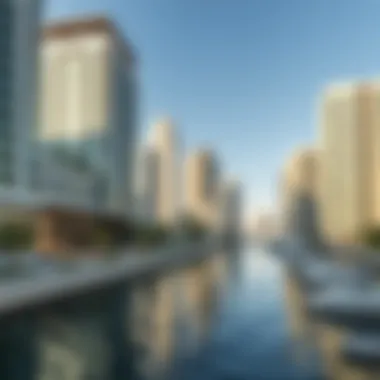
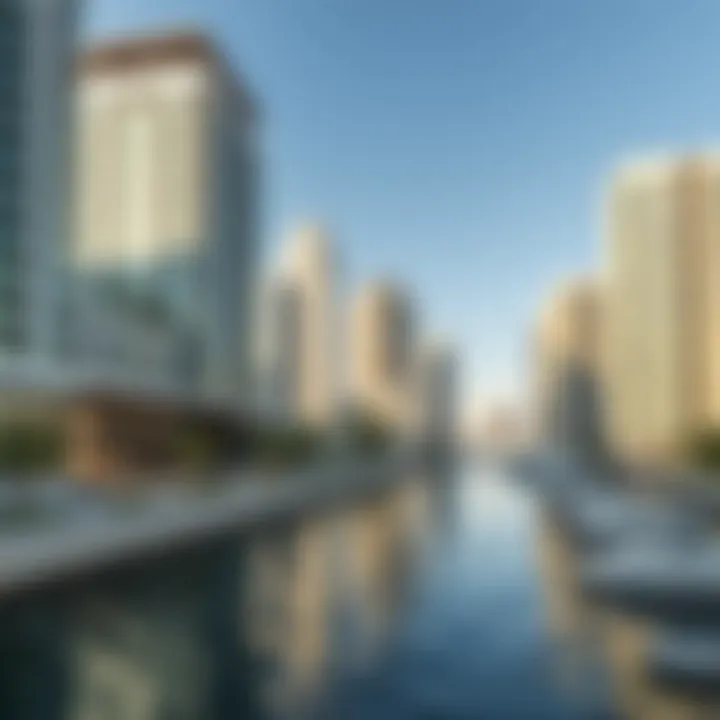
Benefits of Smart Technologies
- Energy Efficiency: Automated systems reduce waste and lower operating costs.
- Safety and Security: Advanced surveillance systems provide improved safety, which is essential in crowded areas.
- User Control: Residents can manage their environments via mobile apps, making for a more personalized experience.
The integration of technologies such as IoT (Internet of Things) means that every aspect of a building can be monitored and controlled, optimizing performance and enhancing user experience. These advancements are especially relevant in Dubai's waterfront developments, where the blending of luxury and functionality is paramount.
Water Management Systems
Water management systems represent another critical area where technology advances in waterfront development. In a region characterized by scarce freshwater and economic reliance on tourism, efficient water management is more than a technical requirement; it's a sustainability imperative. These systems aim to conserve water, minimize wastage, and treat wastewater for reuse, creating a balanced ecosystem that respects the natural environment.
Key Features of Advanced Water Management Systems
- Recycling and Reuse: Greywater systems that recycle water for irrigation and non-potable uses minimize freshwater demand.
- Rainwater Harvesting: Innovative designs incorporate capture systems that utilize precious rainfall, vital in a desert climate.
- Smart Metering: Real-time data collection on water usage helps in quick identification of leaks and inefficiencies, leading to timely interventions.
The implementation of these systems aligns with Dubai's ambitious goals for sustainability and responsible urban growth. Moreover, as residents become increasingly eco-conscious, these advancements can significantly enhance property values, making them attractive to investors.
The intertwining of technology within the fabric of architectural developments lays a foundation for future-proofing urban landscapes, particularly in dynamic cities like Dubai.
Future Outlook for Marine Interfaces
The landscape of marine interfaces in Dubai's waterfronts is not only impressive but also continually evolving. Within this section, we will delve into the significance of exploring the future for these marine environments. Emphasizing upcoming trends and challenges will help stakeholders navigate through Dubai's real estate opportunities effectively.
Emerging Trends and Concepts
As the world shifts increasingly towards sustainability and innovation, Dubai’s waterfront developments can expect several emerging trends that will redefine marine interfaces. Several key trends have started making waves:
- Sustainable design practices: Architects and developers are focusing more on eco-friendliness. Green roofs, energy-efficient systems, and materials designed to minimize environmental impact will be increasingly prevalent in future projects.
- Smart infrastructure: Implementations of Internet of Things (IoT) technologies in building designs, such as smart home systems, integrated energy management, and intelligent landscape management, are expected to be standard practice. These technologies not only enhance connectivity but can also significantly reduce resource consumption.
- Mixed-use developments: There is a growing trend towards combining residential, commercial, and recreational spaces in one unified environment. This blend not only maximizes land use but also promotes community interaction and an active lifestyle. Real estate investors need to be aware of these evolving layouts as they influence market demand.
- Water management innovations: Advanced water recycling systems and innovative purification technologies will be critical parts of marine developments, addressing the region's water scarcity issues entirely. Hard and soft engineering solutions must collaborate to manage stormwater, using permeable paving and natural filtration systems.
From housing to leisure and business use, these trends indicate a commitment to balance luxury and environmental stewardship, paving the way for a more resilient community.
Potential Challenges
While the future of marine interfaces in Dubai seems promising, various challenges lurk beneath the surface that stakeholders must acknowledge:
- Climate impacts: Rising sea levels and extreme weather pose risks to waterfront properties. As investors, understanding how these factors might influence property valuations and capitalize or mitigate risks is crucial.
- Regulatory pressures: Stricter regulations regarding environmental protection, construction practices, and land use can bottleneck new projects. Developers must stay vigilant about policy updates to adapt plans accordingly.
- Market competition: As the UAE government promotes investment in waterfront properties, the market may saturate quickly. Real estate investors must differentiate their projects and offer unique value propositions to stand out in a crowded marketplace.
- Financing hurdles: With the increasing cost of development involving new technologies and sustainable materials, securing financing becomes an uphill battle for many developers. Investors must keep a keen eye on budgeting and return on investment as they navigate these waters.
In summary, the future of marine interfaces in Dubai's waterfront developments hinges on adaptability and foresight. With emerging trends promising innovation and sustainability, while also presenting potential challenges, both investors and stakeholders must approach the marine interface landscape with a nuanced understanding.
"Navigating the future of water interfaces means not just riding the wave of trends but mastering the currents of challenges ahead."
Understanding these dynamics will enable informed decisions that foster growth and resilience in this vibrant sector of Dubai's real estate market.
Closure and Final Thoughts
Waterfront development in Dubai has carved out a niche of its own, representing both a monumental investment opportunity and a canvas of architectural brilliance. The exploration of marine interfaces, as highlighted in this article, showcases their significance not only in enhancing the aesthetic appeal of Dubai's coastline but also in promoting sustainability and community living. The intricate relationship between design, environment, and market dynamics forms the backbone of this thriving sector.
The key takeaways from this discussion are manifold. Understanding the architectural innovations behind iconic facades, weighing the environmental considerations, and recognizing the community's role in shaping these spaces can significantly influence investment strategies. A thoughtful approach to these elements assures that stakeholders, whether investors, agents, or residents, can align their goals with the demands of a rapidly evolving market.
"The real estate landscape of Dubai is not merely about profit; it's about designing lives around shared spaces and sustainable practices.“
As we wrap up this exploration, it becomes clear that waterfront developments will continue to play a pivotal role in the real estate scene, driven by both market demand and ongoing governmental support. Keeping an ear to the ground about emerging trends and potential challenges will enhance the ability of all stakeholders to navigate this vibrant market with foresight.
Recap of Key Insights
- Architectural Flourish: Marina facades showcase a blend of modern aesthetics and cultural references, enhancing Dubai's visual footprint.
- Sustainability Focus: Increasing attention to eco-friendly practices indicates a shift towards harmony between development and the environment.
- Market Resilience: Despite global economic fluctuations, Dubai's waterfront properties demonstrate consistent demand and value appreciation.
- Community Engagement: Effective integration of public spaces fosters a sense of belonging and enhances the lifestyle value of these developments.
Implications for Investors
For investors, understanding the nuances of Dubai’s waterfront developments is not just about seizing immediate opportunities. It’s about anticipating future value in these well-planned environments. Here are several implications to consider:
- Long-Term Value Growth: Properties located in thoughtfully developed marine environments are more likely to appreciate over time due to their balanced design and appeal.
- Diverse Investment Opportunities: With a variety of projects ranging from luxury residential units to commercial spaces, investors have the flexibility to diversify portfolios based on risk tolerance and market forecasts.
- Government Support: Strong governmental backing for waterfront developments provides a safety net, ensuring investors that policies conducive to growth and sustainability are likely to persist.
- Social Dynamics: Understanding community trends and preferences will help investors align their projects with future demands, ensuring both economic viability and social acceptance.
Understanding these facets equips investors and stakeholders with a comprehensive framework to make informed decisions, ultimately leading to profitable ventures in the vast ocean of Dubai’s waterfront landscape.



